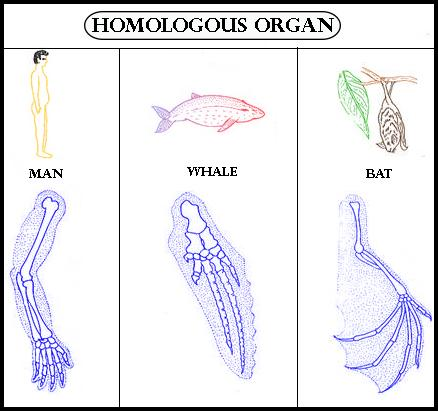
Human hand, the wing of a bat, and the flipper of a whale represent
(a)Analogous organs
(b)Vestigial organs
(c)Homologous organs
(d)Evolutionary organs
Answer
498.3k+ views
1 likes
Hint: A body part with the same structure between some groups of organisms due to inheritance from the same ancestor, though not necessarily sharing the same function.
Complete answer:
Homologous structure helps in recognizing the same behavioral characteristics which are modified in different sub-species by their environment.
-Example-
Pentadactyl limbs- bones of limbs of vertebrates are very similar but the functions of each forelimb are different.
-Importance of homologous structure-
To provide a track of evolutionary paths
Diverges between species and subspecies.
Additional Information: -Analogous structures are structures present in different species with similar features in function but not necessarily in structure.
Example- the wings of the insects and birds.
-Vestigial organ- The structures or organs that are not useful are termed as vestigial like, humans have a tailbone, some snakes have limb bones, some salamanders have eyes although they are blind, etc.
Example- the coccyx, or tailbone, in humans.
So, the correct answer is, ‘homologous organs.’
Note: -To have a homologous structure does not always have an analogous structure.
-A study on comparative anatomy involves studying and comparing the structure of different organs. Two organisms are related if their organs internal structure, even if they are shaped differently. There are-
Homologous organs
Analogous organs
Vestigial organs

Complete answer:
Homologous structure helps in recognizing the same behavioral characteristics which are modified in different sub-species by their environment.
-Example-
Pentadactyl limbs- bones of limbs of vertebrates are very similar but the functions of each forelimb are different.
-Importance of homologous structure-
To provide a track of evolutionary paths
Diverges between species and subspecies.
Additional Information: -Analogous structures are structures present in different species with similar features in function but not necessarily in structure.
Example- the wings of the insects and birds.
-Vestigial organ- The structures or organs that are not useful are termed as vestigial like, humans have a tailbone, some snakes have limb bones, some salamanders have eyes although they are blind, etc.
Example- the coccyx, or tailbone, in humans.
So, the correct answer is, ‘homologous organs.’
Note: -To have a homologous structure does not always have an analogous structure.
-A study on comparative anatomy involves studying and comparing the structure of different organs. Two organisms are related if their organs internal structure, even if they are shaped differently. There are-
Homologous organs
Analogous organs
Vestigial organs

Latest Vedantu courses for you
Grade 11 Science PCM | CBSE | SCHOOL | English
CBSE (2025-26)
School Full course for CBSE students
₹41,848 per year
Recently Updated Pages
Master Class 10 General Knowledge: Engaging Questions & Answers for Success

Master Class 10 Computer Science: Engaging Questions & Answers for Success

Master Class 10 Science: Engaging Questions & Answers for Success

Master Class 10 Social Science: Engaging Questions & Answers for Success

Master Class 10 Maths: Engaging Questions & Answers for Success

Master Class 10 English: Engaging Questions & Answers for Success

Trending doubts
A boat goes 24 km upstream and 28 km downstream in class 10 maths CBSE

Why is there a time difference of about 5 hours between class 10 social science CBSE

The Equation xxx + 2 is Satisfied when x is Equal to Class 10 Maths

Chandigarh is the capital of A Punjab B Haryana C Punjab class 10 social science CBSE

Change the following sentences into negative and interrogative class 10 english CBSE

Discuss the main reasons for poverty in India




